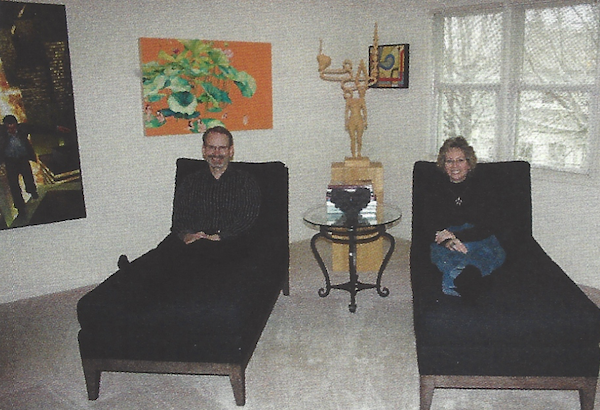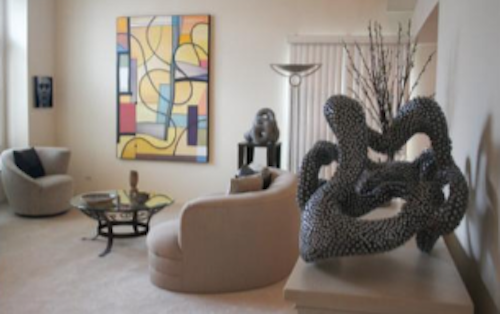Collector Profile: Anne and Mark Siebert

By GINNY VAN ALYEA
Collectors Anne and Mark Siebert bought a house in suburban Naperville 21 years ago, and though they like their quieter pace of life 30 miles outside of Chicago, they have become devoted city gallery visitors.
After first meeting artist Peter Max one day at a suburban mall, they were so delighted with the personal experience that they started venturing downtown in search of more. They found a community ready to teach and welcome them with open arms, and many of those relationships have become two-way dialogues with artists and dealers that have opened up their world and shown them that art can indeed change your life. - GV
Sitting down over coffee and pastries in their tidy kitchen, Mark and Anne tell me when they first realized how eye-opening art could be as a part of their day-to-day life. Mark admits that the first spark ignited in a suburban shopping mall in the late 1990s when they wandered into Merrill Chase Gallery, where painter Peter Max was having an exhibition.
Mark laughs and remembers thinking, “‘He’s a really famous artist. Let’s go in.’ So we met him. And we actually bought something.”
To Anne seeing an artist’s passion in person was a revelation, and she wanted more. The couple plunged headfirst into what would become an art collecting addiction. Seeking art in gallery spaces in the city, they ventured in by train and introduced themselves to dealers, attended dozens of openings and panel discussions, as well as BFA and MFA shows at the School of the Art Institute Chicago.
They got know a number of artists, such as Dan Addington (also a dealer), whose piece was the second one they purchased in River North (Ron Clayton, represented by Addington's gallery, was the first), and William Conger. The dealers they met, like Ann and Roy Boyd of Roy Boyd Gallery, Frank Paluch of Perimeter Gallery, Myra Casis and Meg Sheehy at Zg Gallery, and William Lieberman of Zolla/Lieberman all took the eager new collectors under their collective wing to help them learn. Coming to downtown galleries to see what was new soon became an escape from a structured 9-5 life.

To learn more about this new scene, Mark and Anne started going on the free River North Saturday Gallery Tours when they began over a decade ago. Mark recalls, “We continued to go on the tours even after we started to collect. Any space we go into, if you want a direction to explain about the gallery or the artists, they’re more than happy to do it, but on the tour you get so much more additional background. Even with artists we’re familiar with, when we hear the dealer talk we learn something we didn’t know before.”
The Sieberts approached their newly discovered passion for art like dedicated students and did their homework.
According to Anne, “Neither one of us has a background in art, but once we went to River North, that was it for the malls. We were captivated. Our tastes changed really quickly—they’re changing still even now.”
*
The Sieberts have lived in the same house in Naperville for 21 years. Having made some updates over the years, their most significant change seems to be the addition of artwork to almost every wall and tabletop.
According to Anne, “Everything else is pretty bland in our home—it’s all beige and black, so we’re not limited by colors. We fall in love and make it work.”
Their collecting approach is very straightforward, “There is no formula where we think, 'OK, now we have to get this type of art or that type.' We try to keep things different—various materials and mediums, young artists as well as established—in order to have a range.”

Connecting with artists has been a particular source of engagement for the couple. “We’re proud of the fact that we support local Chicago galleries. We have purchased art from 13 Chicago galleries, and many of the artists in our collection are local. We treasure our relationships with all of the artists that we’ve gotten to know,” says Anne.
About sculptor Josh Garber Mark shares, “We have lunch or dinner with him, or he’ll have us out to his studio. Sometimes he runs ideas by us. At an opening after he’d just found out that he was a finalist for a commission for the City [of Chicago], he was sketching and asking what we thought. It was fascinating to be in that kind of discussion with him.”
Anne says they even give him a little feedback when he asks, “I think Josh lets us in on the process. He shows us prototypes—sometimes we snap them up. That’s a lot of fun for us. I think when artists are surrounded by other artists maybe they forget how unique their talents are. As non-artists, we want to tell them how phenomenal their gift is. I think they need to hear it. And anyway, I’m not sure anyone could even stop us from telling them ‘fabulous job!’ I think artists are thrilled with each chance to talk to interested people. They’re all so willing to share with us.”
William Lieberman says there’s something special about the relationship with Garber, “Anne and Mark both elevate his process. Josh is so into it—his whole existence revolves around his art. They make him feel it’s really important. They help artists feel good about who they are.
*
Nearly every piece in the collection has a backstory that the Sieberts are eager to share. A painting by Betty Cleeland, black with scattered bits of red and yellow, hangs in the family room by the TV. Anne tells me that they ended up buying the work when the shuttle Columbia exploded in 2003. The Sieberts watched the news before heading into the city to visit Roy Boyd Gallery. “Betty says you’re either looking through the end of a microscope or a telescope. The painting was a reminder of the mysteries of the universe and the need for space exploration. It especially struck us on that day.”
In a tiny room off of the hall is one of Nicholas Sistler’s diminutive works. Mark explains it is based on erotica from the Weimar Republic in Germany, commenting on what many women had to do to make ends meet after WWI. The charged scene is almost too small for the casual observer to see, but Anne clearly recalls a day when a plumber, finishing up some work in the house, had his nose practically in the piece, astounded at the small scale of discovery of a naked woman in a compromising position.
She remembers, “I was torn whether or not to pretend to be shocked. His expression was priceless.”
•
Mark is an insurance attorney, and Anne is a biologist turned textbook representative. She explains, “What we do certainly colors our experience. We tend to be very black and white and analytical in the way we evaluate things. Collecting art has sort of given us the gray. That artistic element is an interesting layer for us that’s added a dimension that didn’t exist before we started collecting. It wasn’t a part of how we used to think.”
Looking ahead, Anne reflects, “We plan to be with this art for quite a while, but we get the sense that it will exist beyond us. Since almost all of our works are originals, we lend whenever there’s a request. All an artist has to do is ask. They are also invited to come here to visit their art anytime too, since it’s a part of them."






